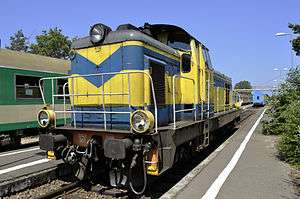PKP class SU42
SU42 is the name for a Polish diesel locomotive used for universal purposes.
| PKP SU42 | |||||||||||||||||||||||||||
|---|---|---|---|---|---|---|---|---|---|---|---|---|---|---|---|---|---|---|---|---|---|---|---|---|---|---|---|
 SU42 locomotive | |||||||||||||||||||||||||||
| |||||||||||||||||||||||||||
| |||||||||||||||||||||||||||
| |||||||||||||||||||||||||||
| |||||||||||||||||||||||||||
History
The SU42 is in fact the same locomotive as SM42 and SP42. The original class SU42 were modifications of Class SM42 done during the 1970s. This modification involved a 500 Volt heating powered directly by locomotive's main engine. The class retained the original SM42 serial number, however most of those converted have now been converted back to SM42 or withdrawn.
The newer class were modified between 1999 and 2000 from class SP42. The modification centered on the addition of electric train heating. They were classified as class SU42-5xx. 40 of the class were eventually modified and they are based at various depots across the network. Unlike previous iteration, SU42-5xx has electric train heating powered by a separate Caterpillar diesel engine, thus increasing locomotive's main engine output while heating the train.
Built for shunting purposes SM42, after shifting into SP42 and SU42 is widely used in passenger traffic on non electrified lines.
Nicknames
The described loco used to be called by the following names:
- Zebra - from the painting
- Wibrator (eng. Vibrator) - the vibrations the engine produced
- Eleska - from the factory number: Ls800
- Fablok - from the producer
- Polsat - from livery similar to one popular TV operators' colours in Poland
See also
- Polish locomotives designation